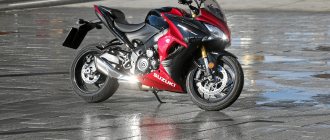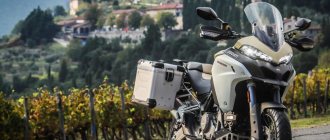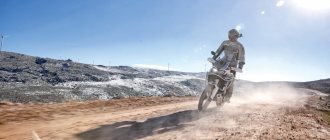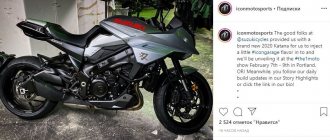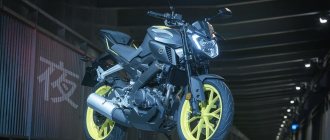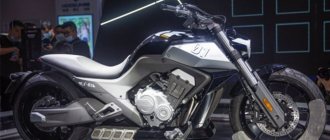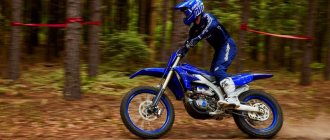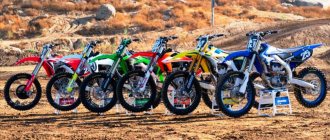- motorcycle model, Suzuki brand
The Suzuki GSX1250FA sports tourer model appeared in 2010 on the basis of the Suzuki GSF1250 Bandit road model, essentially representing one of the Bandit 1250 trim levels. It is noteworthy that the Bandit prefix was not available in all markets - in particular, in Japan the GSX1250FA model was also called the Suzuki Bandit 1250F .
The basis for the Suzuki GSX1250FA was an in-line 4-cylinder liquid-cooled engine with a volume of 1255 cm³ and producing 100 hp. power and 107 Nm of torque. The motor is completely identical to that installed on the Suzuki GSF1250 Bandit.
The Suzuki GSX1250FA model differs from the Suzuki GSF1250 Bandit, first of all, by the presence of a full plastic body kit and an ABS system as standard equipment. In all other respects, these are identical motorcycles.
Features include a steel duplex frame, adjustable suspension in the form of a conventional telescopic fork at the front (adjustable for preload) and a monoshock absorber at the rear (adjustable for preload and rebound), 4-piston disc brakes at the front, 6-speed gearbox, chain drive and 257 kg of curb weight. masses.
2016 was the last year of production of the Suzuki GSX1250FA model and, in general, the entire Suzuki Bandit 1250 series.
Brief history of the model
2010 - start of production and sales. Model: Suzuki GSX1250FA (Bandit 1250F) (Japan, North America, Europe, Oceania). Factory designation: GSX1250FAL0.
2011 - no significant changes. Model: Suzuki GSX1250FA (Bandit 1250F) (Japan, North America, Europe, Oceania). Factory designation: GSX1250FAL1.
2012 - no significant changes. Model: Suzuki GSX1250FA (Bandit 1250F) (Japan, North America, Europe, Oceania). Factory designation: GSX1250FAL2.
2013 - no significant changes. Model: Suzuki GSX1250FA (Bandit 1250F) (Japan, North America, Europe, Oceania). Factory designation: GSX1250FAL3.
2014 - no significant changes. Model: Suzuki GSX1250FA (Bandit 1250F) (Japan, North America, Europe, Oceania). Factory designation: GSX1250FAL4.
2015 - no significant changes. Model: Suzuki GSX1250FA (Bandit 1250F) (Japan, North America, Europe, Oceania). Factory designation: GSX1250FAL5.
2016 is the last year of production. Model: Suzuki GSX1250FA (Bandit 1250F) (Japan, North America, Europe, Oceania). Factory designation: GSX1250FAL6.
Suzuki GSX1250FA (Bandit 1250F) motorcycle review
This is not a motorcycle, this is a real limousine on two wheels!
The city roads of Yoshkar-Ola, and the country roads in some places, frankly speaking, are not so hot. There don’t seem to be any holes, but it’s shaking quite a bit. That's it! Everywhere is smooth! Now I'm on "LIMUBANDITE"!
The front fork and rear monoshock allow you to configure the suspension as you like. The adjustments are, of course, standard: spring preload at the front and rebound travel with preload at the rear. This, I assure you, is quite enough. But it’s not just the suspension that allows you to ride in a thrill without jumping on bumps. BANDIT 1250 - heavy - 257 kg dry weight, and with me, oil (oil, gasoline), etc. so everything will be 380.
Motor is a song! It pulls from idle without gas. In the city I turn on third and drive - it will suit any driving mode. FANTASTIC! Like on Zhenya’s scooter! Gas and brake! The gears are switched on clearly, but a little harshly. The neutral is caught at once. There is a gear engaged indicator on the instrument panel.
“Bandit” rear view mirrors - SUPERRRRR!!! You can see everything and everyone!
On the track it’s even better - everything is smooth and predictable. Need acceleration - please! Immediately and as much as needed! Overtaking a truck - instantly! Wind protection is beyond praise - no chatter. The plastic hood and fairing provide excellent protection, which, of course, has a positive effect on aerodynamics. For my build and height (176 cm, 90 kg), a comfortable speed is 100-120 km/h - after that I begin to feel that the Earth has an atmosphere.
The seat is very comfortable. Direct landing, wide, medium-soft seat, standard remote controls, footrests where I need them - my legs don’t get tired. Comfortable! It's good when you don't have to get used to it. It was as if the motorcycle was made personally for me. The very first hold at 240 km confirmed my feelings.
Brakes with ABS. Some say they are rather weak. For me, that’s just it, they brake normally at any speed.
And the moto also has a trump head light in stock! The visibility is great on a dark night! A clear, even beam of light from edge to edge of the road. Very happy!
The instrument panel is a symbiosis of a dial tachometer and a digital speedometer, odometer, clock, etc. Has a nice backlight. Everything, of course, is regulated and customizable. I figured it out for two days, then I found a manual in Russian - five minutes was enough.
Fuel tank - 19 liters. In the mixed (50% city, 50% highway) cycle, I drove 382 km on the tank and there was still quite a bit of splashing. You can’t dry it - the pump will burn out.
Two more stock features are encouraging. These are hazard warning lights and heated steering wheel grips. The handles heat up perfectly, but only in one mode, I would say, too well. I didn't find anything about heating in the manual.
Bandit is super, I ride a big one myself.
In terms of consumption, of course, this is only when you feel sick. I had something like this when we were pooping around Europe. If there is no autobahn there, then such an expense can be arranged.
As for the seat, nothing gets tired on it. Tested by our own 5th point, over 7000 km in 13 days.
Regarding drying the fuel pump, this is debatable, since it turns off without gasoline. Verified. I took mine apart and wanted to change it, but I got away with cleaning the filter. So, if you start it with gasoline, it simply turns off. Actually, the protection is against a fool and an empty tank.
The wind protection copes well up to 140-150, taking into account the fact that my glass is already higher. But I’m thinking of getting even larger glass for long-distance travel.
Suzuki GSX-S1000
For the first time we found ourselves driving both versions of the Suzuki GSX-S1000 on mountain roads. Some readers may consider Suzuki's lines not expressive; personally, I like them much more than their aggressive rivals. By the way, the build quality of the new GSX-S exceeds expectations, especially at this price point. In this respect, the new models are the antithesis of the old GSX1250FA, which seemed overpriced, flimsy and a mess of parts compared to other bikes. And the new bikes, if you look at the controls on the console and the easy-to-read LCD screen, are reminiscent of the latest generation V-Storm.
The 810mm seat height allows me to easily reach the ground with my feet. As for the shape of the seat, as is common today, it tapers towards the fuel tank. At first glance, I liked the aluminum handlebar of the Rental Fathbar design; when you sit behind it, the motorcycle seems light and elegant, there is no clutter of buttons and levers.
One of the “chips” of the Suzuki GSX-S1000 is the Easy Start function , with which the motorcycle starts with a light touch of the starter button (pilots also do not need to depress the clutch, provided that the gearbox is in the neutral position). Of course, holding your thumb a second longer to move the engine is no problem on a regular motorcycle, but this feature comes standard on the GSX-S. Of course, what happens after the bike ignites is much more important.
The Suzuki GSX-S1000 takes its power from the GSX-R1000 version of the K5 inline-four. Parameters such as volume (999 cm3) and cylinder diameter and stroke (73.4 mm × 59 mm) remained unchanged. But engineers tuned the Model S engine for street driving. New pistons, new profile cams and valve adjustments (now made from steel instead of titanium) are the most noticeable improvements. Power at high engine speeds has been reduced in favor of high torque in the low and mid-range. The manufacturer says the Model S produces 145 horsepower and 105.8 pound-feet of torque. Suzuki also emphasizes that the S produces more low- and mid-range torque than its R sibling. By comparison, the GSX-R1000 produces 185 horsepower at 11,500 rpm, which is surprisingly in line with the S's limit.
About the practical application of Suzuki GSX-S1000F
If we talk about the practical use of the Suzuki GSX-S1000F, the engine is perfectly tuned for city driving. The Model S is content to only accelerate in the low rev range, but becomes more fun in the mid rev range. Fuel delivery is instantaneous, and the throttle valve goes from fully open to closed without hesitation. Twist the throttle and you'll have more than enough power to tackle city streets. And when it comes to high revs, it becomes even more fun. The motorcycle can be called sporty with full confidence, and only avid power lovers will be able to discern in it a tamed copy of the GSX-R. This is where it differs from its main rival, the CBR1000R, which feels stifled compared to its liter sibling.
I was equally impressed by the sound of the Suzuki GSX-S1000F motorcycle. When I fully cranked the throttle on the highway, the horrendous whine from the intake system made me smile stupidly, and the sound from the exhaust was truly surprising. The engine's power can be dizzying, but at the same time it is easy to control thanks to its excellent balance. The GSX-S is equipped with traction control. A switch located on the right allows the pilot to select one of four options: three levels of intervention (1, 2, 3), or the traction control can be turned off completely. For most of the test drive, the traction control switch was set to level 1, this level has minimal intervention and allows for slipping. The system as a whole has proven to be effective.
The six-speed transmission of the Suzuki GSX-S1000F has no additional devices. There's no slipper clutch or quickshifter, but I don't regret their absence at all. Shifting gears is incredibly easy: no drops or any other complaints.
If we talk about the handling of the Suzuki GSX-S1000F, then the motorcycle fully justifies its sporty nature. The bike consists of an aluminum bias frame (lighter than the R model) and a swingarm similar to the GSX-R. The S isn't as aggressive or sharp as a track bike, but it's responsive and turns in quickly. On a narrow one-way road, a car unexpectedly drove towards me, but I was able to steer out and managed with only a slight fright. The motorcycle moves very steadily.
The suspension of the Suzuki GSX-S1000F consists of KYB components: 43mm inverted forks and a single rear shock absorber. Our test drive route didn't just cover smooth highways, there were also a few bumpy sections. The GSX-S's vaunted suspension didn't fare well in these areas. But I can't be completely objective because I haven't used all the settings offered: the fork has adjustable preload, compression and rebound, and the shock has adjustable preload and rebound.
GSX-S 1000F
Suzuki GSX-S 1000F
The Suzuki GSX-S 1000F version is the same motorcycle, but with a fairing. The extra bodywork adds nearly 6kg to the naked's claimed curb weight of 208kg. To compensate for the increased weight and the aerodynamic effect of the fairing, the fork has an increased oil reserve. In all other respects the bikes are identical. Surprisingly, in the first minutes the F version seemed smoother to me. I'm guessing this was due to the road surface. The GSX-S1000F corners beautifully. But even with the impeccable road surface, I'd still say the F's front end is more composed than the naked's. I think that the improved aerodynamics of the fairing and windshield play a decisive role in this.
Another oddity I noticed is that the front brakes on the F model are not as powerful. In fact, when I slammed on the brakes as hard as I had driven the S earlier that morning while approaching a corner, I was a little scared and had to push harder. I didn't have any complaints about the S1000's braking system, so I believe this incident was a feature of this particular Suzuki GSX-S 1000F bike (maybe the new brake rotors haven't yet broken in). Suzuki says it uses the same Brembo monobloc calipers found on the 2014 GSX-R models. I thought this was amazing. Overall, the braking system is good, but not great. ABS is standard on the F version and available at extra cost on the S version.
Unfortunately, the GSX-S1000F model does not come with a saddle bag, otherwise it could confidently be called a sports tourer. The last representative of this segment in the Suzuki line-up was the aforementioned GSX1250FA. It's been a few years since I've driven a 1250. But my recollection is that the new 1000F has sportier suspension and handling.
Comfort may not be ideal compared to true touring bikes, and the biggest issue is the seat. The upright, slightly sporty driving position is ideal for long journeys. The fairing does its job well despite its relatively thin profile. Of course, the windshield cannot be called exclusively touring, but I have no complaints about it. I'll admit I haven't driven the F far enough to fully appreciate its sport-touring capabilities, but I plan to do so in the near future and suspect it will be a success.
I think the most interesting aspect of the GSX-S models is the price. More specifically, the Suzuki GSX-S 1000F is cheaper than its direct competitor, the Ninja 1000 ABS. It is clear that Suzuki's pricing policy is aimed at the category of buyers that we talked about at the very beginning. If these bikes had appeared on the American market a couple of years ago, they would have influenced it much more. But GSX-S1000 motorcycles can be bought now at a very reasonable price. They are a great choice for drivers who want sporty performance in a street-ready platform.
Advantages of SUZUKI GSX-S1000F:
· Sporty performance and touring ergonomics
Engine sounds great for a stock exhaust system
· Competitive price
Disadvantages of SUZUKI GSX-S1000F:
No optional saddle bag for F model
· Throttle valve closes a little harshly
· Appeared two years later


